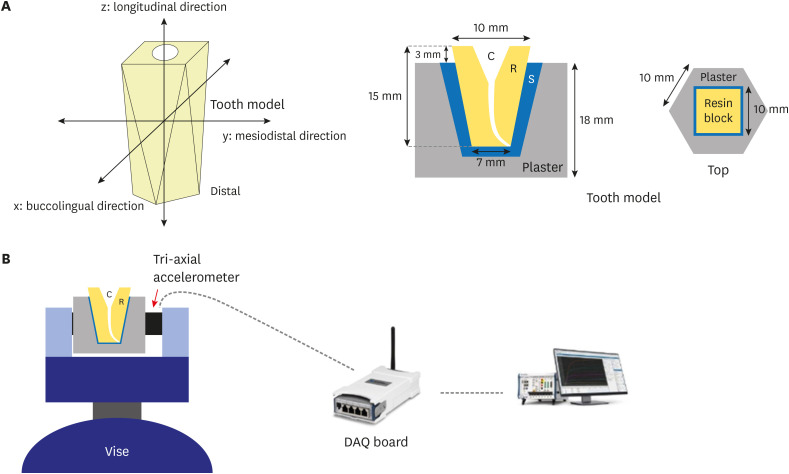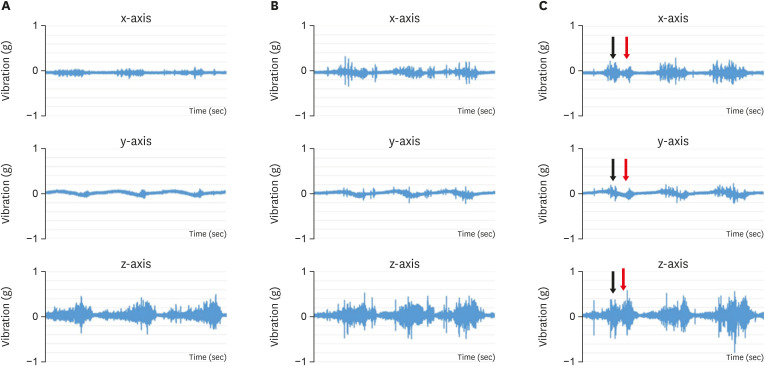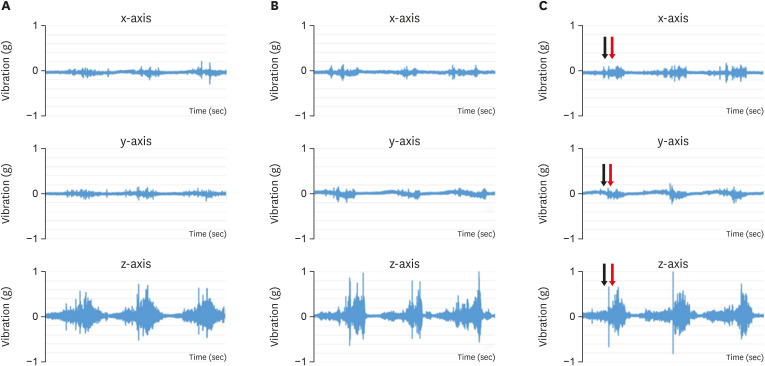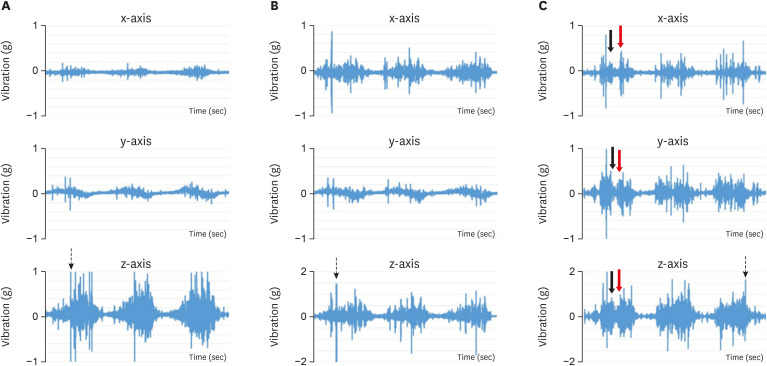Restor Dent Endod.
2020 Nov;45(4):e51. 10.5395/rde.2020.45.e51.
Comparison of vibration characteristics of file systems for root canal shaping according to file length
- Affiliations
-
- 1Department of Conservative Dentistry, Gangneung-Wonju National University, Gangneung, Korea
- 2Department of Conservative Dentistry, Hanyang University Seoul Hospital, Seoul, Korea
- KMID: 2512042
- DOI: http://doi.org/10.5395/rde.2020.45.e51
Abstract
Objectives
No studies have yet assessed vibration characteristics according to endodontic file length. Accordingly, the objective of the present study was to examine the vibration characteristics according to nickel-titanium file length and to compare these characteristics between different file systems.
Materials and Methods
A total of 45 root canal models were divided into 3 experimental groups (n = 15 each) based on the file system used (ProTaper Gold [PTG], ProTaper Next, or WaveOne Gold [WOG]). Each experimental group was further divided into 3 subgroups according to file length (21, 25, or 31 mm). An electric motor (X-SMART PLUS) was used in the experiment. For each file system, vibrations generated when using a size 25 file were measured and used to calculate the average vibration acceleration. The differences in vibrations were analyzed using 1-way analysis of variance and the Scheffé post hoc test with a confidence interval of 95%.
Results
In the PTG file system, significantly lower vibration acceleration was observed when using a 21-mm file than when using a 31-mm file. In the WOG file system, significantly stronger vibration acceleration was observed when using a 31-mm file than when using 21- or 25-mm files. Regardless of the file length, the WOG group exhibited significantly stronger vibration acceleration than the other 2 experimental groups.
Conclusions
In clinical practice, choosing a file with the shortest length possible could help reduce vibrations. Additionally, consideration should be given to vibrations that could be generated when using WOG files with reciprocating motion.
Keyword
Figure
Cited by 1 articles
-
Comparison vibration characteristics of several wireless endodontic handpieces
Bo-Kyung Lee, Yoon Lee, Se-Hee Park, Kyung-Mo Cho, Jin-Woo Kim
J Dent Rehabil Appl Sci. 2022;38(2):81-89. doi: 10.14368/jdras.2022.38.2.81.
Reference
-
1. Grande NM, Ahmed HM, Cohen S, Bukiet F, Plotino G. Current assessment of reciprocation in endodontic preparation: a comprehensive review-part I: historic perspectives and current applications. J Endod. 2015; 41:1778–1783. PMID: 26514866.
Article2. Shen Y, Zhou HM, Zheng YF, Peng B, Haapasalo M. Current challenges and concepts of the thermomechanical treatment of nickel-titanium instruments. J Endod. 2013; 39:163–172. PMID: 23321225.
Article3. Plotino G, Ahmed HM, Grande NM, Cohen S, Bukiet F. Current assessment of reciprocation in endodontic preparation: a comprehensive review--part II: properties and effectiveness. J Endod. 2015; 41:1939–1950. PMID: 26480824.
Article4. Topçuoğlu HS, Topçuoğlu G. Cyclic fatigue resistance of Reciproc Blue and Reciproc files in an S-shaped canal. J Endod. 2017; 43:1679–1682. PMID: 28733080.
Article5. Özyürek T. Cyclic fatigue resistance of Reciproc, WaveOne, and WaveOne Gold nickel-titanium instruments. J Endod. 2016; 42:1536–1539. PMID: 27520406.
Article6. Uygun AD, Kol E, Topcu MK, Seckin F, Ersoy I, Tanriver M. Variations in cyclic fatigue resistance among ProTaper Gold, ProTaper Next and ProTaper Universal instruments at different levels. Int Endod J. 2016; 49:494–499. PMID: 26011308.
Article7. Silva EJ, Muniz BL, Pires F, Belladonna FG, Neves AA, Souza EM, De-Deus G. Comparison of canal transportation in simulated curved canals prepared with ProTaper Universal and ProTaper Gold systems. Restor Dent Endod. 2016; 41:1–5. PMID: 26877984.
Article8. Vadhana S, SaravanaKarthikeyan B, Nandini S, Velmurugan N. Cyclic fatigue resistance of RaCe and Mtwo rotary files in continuous rotation and reciprocating motion. J Endod. 2014; 40:995–999. PMID: 24935551.
Article9. Ahn SY, Kim HC, Kim E. Kinematic effects of nickel-titanium instruments with reciprocating or continuous rotation motion: a systematic review of in vitro studies. J Endod. 2016; 42:1009–1017. PMID: 27185740.
Article10. Jeon YJ, Kim JW, Cho KM, Park SH, Chang HS. Vibration characteristics of endodontic motors with different motion. J Korean Diet Assoc. 2014; 52:734–743.11. Choi DM, Kim JW, Park SH, Cho KM, Kwak SW, Kim HC. Vibrations generated by several nickel-titanium endodontic file systems during canal shaping in an ex vivo model. J Endod. 2017; 43:1197–1200. PMID: 28454634.
Article12. Di Nasso L, Nizzardo A, Pace R, Pierleoni F, Pagavino G, Giuliani V. Influences of 432 Hz music on the perception of anxiety during endodontic treatment: a randomized controlled clinical trial. J Endod. 2016; 42:1338–1343. PMID: 27430941.
Article13. Kalpakjian S. Manufacturing engineering and technology. London: Pearson Education;2001.14. Siddhpura M, Paurobally R. A review of chatter vibration research in turning. Int J Mach Tools Manuf. 2012; 61:27–47.
Article15. Quintana G, Ciurana J. Chatter in machining processes: a review. Int J Mach Tools Manuf. 2011; 51:363–376.
Article16. Zupanc J, Vahdat-Pajouh N, Schäfer E. New thermomechanically treated NiTi alloys - a review. Int Endod J. 2018; 51:1088–1103. PMID: 29574784.
Article17. Isik V, Kwak SW, Abu-Tahun IH, Ha JH, Kayahan MB, Kim HC. Effect of shaft length on the torsional resistance of rotary nickel-titanium instruments. J Endod. 2020; 46:295–300. PMID: 31812358.
Article18. Gagliardi J, Versiani MA, de Sousa-Neto MD, Plazas-Garzon A, Basrani B. Evaluation of the shaping characteristics of ProTaper Gold, ProTaper NEXT, and ProTaper Universal in curved canals. J Endod. 2015; 41:1718–1724. PMID: 26321062.
Article19. Nayak A, Kankar PK, Jain PK, Jain N. Force and vibration generated in apical direction by three endodontic files of different kinematics during simulated canal preparation: an in vitro analytical study. Proc Inst Mech Eng H. 2019; 233:839–848. PMID: 31165678.
Article20. Ruddle CJ. Single-file shaping technique: achieving a gold medal result. Dent Today. 2016; 35:98–103.21. Yoo YJ, Lim BS, Kim JW, Baek SH, Lee IB. Assessment of torque and apical load during root canal preparation using reciprocating nickel-titanium files. Korean J Dent Mater. 2014; 41:9–18.
Article
- Full Text Links
- Actions
-
Cited
- CITED
-
- Close
- Share
- Similar articles
-
- Selection of Nickel-Titanium Files according to the Clinical Procedure and Factors of File Fracture: A Narrative Review
- Relative efficacy of three Ni-Ti file systems used by undergraduates
- A comparison of the shaping ability of reciprocating NiTi instruments in simulated curved canals
- Shaping ability of nickel-titaniumrotary files
- Comparison of shaping ability between single length technique and crown-down technique using Mtwo rotary file





